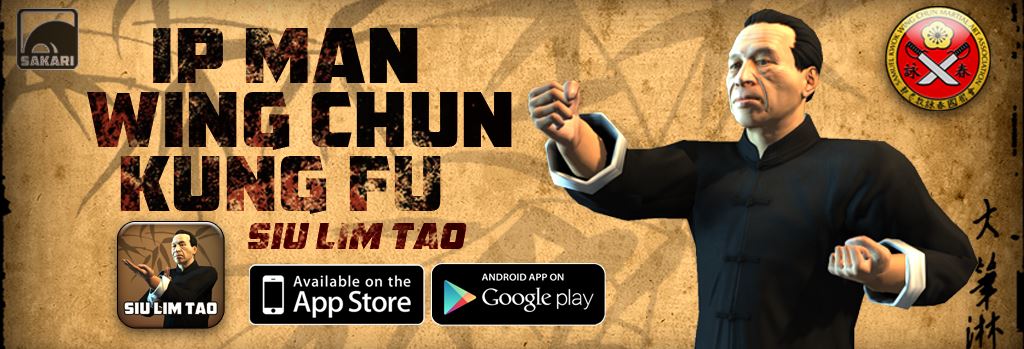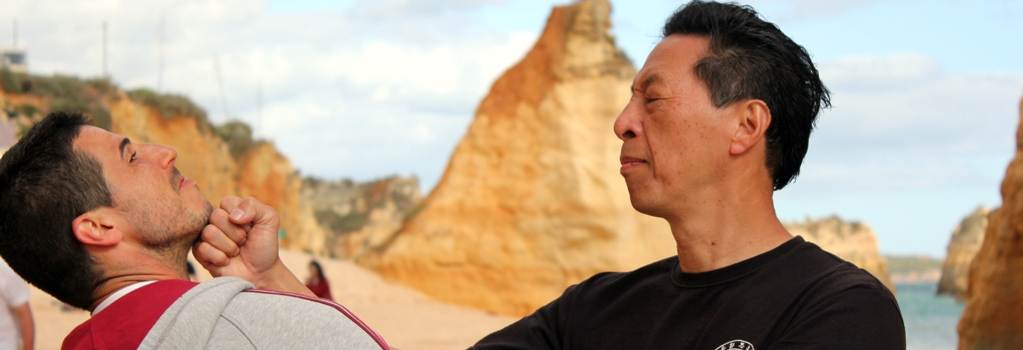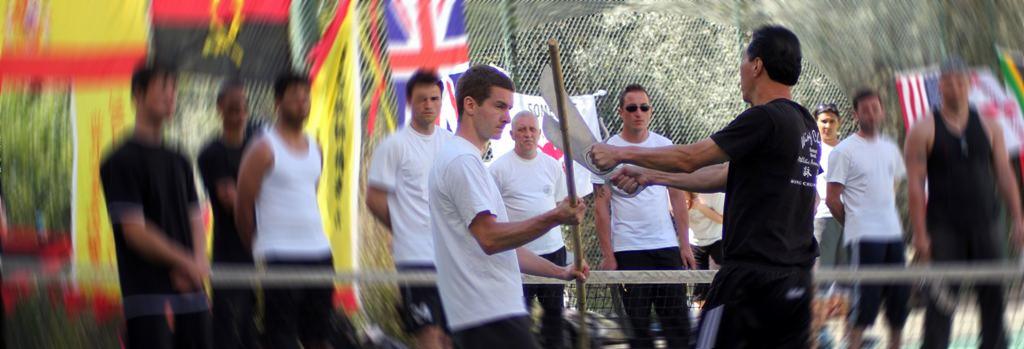Abdominal and Core Muscles
Article by Dan Knight added on 26 Aug 2012.
Abdominal & Core Muscles For Martial Arts
More power, speed and balance for fighting
There is a lot of often conflicting information about training your abdominal muscles. So I will start by saying don't listen to me, and certainly don't listen to anyone trying to make you pay for "secrets", instead listen to your body. That is the easy way to success.
Safety Notice
Strength training, and body conditioning of any part of your body including your core, trunk and abs Will involve strenuous activity. Do so at your own risk and consult a doctor if you are in any doubt about your physical abilities.
What is all this talk about Core, Trunk and Abs?
The Trunk
People often mean different things when they refer to the trunk. However for the sake of simplicity for this article I will use it to describe the body. ie not the arms, legs or the head.
Abdominal Muscles
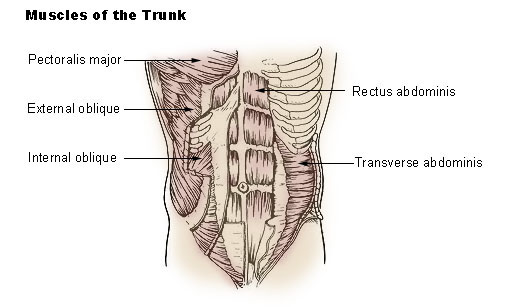 Lets start with the abs, most people know roughly what is meant when we say abs, "That's the six pack right?". Yes. The Rectus Abdominal muscle is the muscle that runs down the front of the body from the sternum to the groin and is what most people call the "six pack". However this is not six muscles its just one muscle. It has a number of sections of which normally 6 or 8 will show on learn and well trained individuals.
Lets start with the abs, most people know roughly what is meant when we say abs, "That's the six pack right?". Yes. The Rectus Abdominal muscle is the muscle that runs down the front of the body from the sternum to the groin and is what most people call the "six pack". However this is not six muscles its just one muscle. It has a number of sections of which normally 6 or 8 will show on learn and well trained individuals.
Then there's the Traverse Abdominal Muscles these run horizontally across the base of the body. The Abs are an external muscle group ie you can see them if you are lean as they are near the surface and you can actively tense and relax them when you want. The Abs provide support for the body, help with bending and straightening and can act as armour to protect the organs from damage.
The Obliques
The Obliques are another muscles group at the outside edge of the trunk. There are external obliques which are visible and internal obliques which are not visible. Obliques aid power generation in martial arts by helping turning power and balance etc.
The Core
The Core refers to all the tiny muscles in the back and around the spine particularity the lower part of the spine. There are many tiny sheets of muscle that hook into the spin and ensuring they are strong will prevent damage and improve balance and stability particularity when deflecting attacks or absorbing returning force from strikes and kicks in Wing Chun. People often mistakenly refer to the abs as the core.
So why train your abdominal & core muscles?
Firstly, it is a set of muscles that many modern lifestyles don't use much. Even an office worker probably has to walk up and down stairs and pick things up and move around, this will mean they are using their legs and arms. However there is much less need to engage the abdominal or core muscles on a day to day basis.
Secondly, in martial arts your core strength plays a huge role in stability and balance and your obliques help the power of strikes like punches and kicks. Boxing, Wing Chun and almost all martial arts talk about pushing power from the ground into a punch. A powerful punch starts with a push from a leg the force then moves through the body, shoulder, arm and to the fist. If you have a weak core the punch will lose some of the power the legs generated. With strong obliques you will add to that power. A Wing Chun turning punch is a classic example of how the muscles in the trunk of the body will affect the power of a punch.
Thirdly your rectus and traverse abdominal muscles protect your organs from damage. This is obviously useful for martial artists.
Fourthly, many martial artists train their back muscles to develop powerful punches. This is a good thing however the abdominal muscles are the opposing set of muscles to the back. If there is a big imbalance the martial artist will experience back pain and may end up with ruined posture later in life. Equally if the front muscles are much stronger than the back the same problems will occur.
Finally and less important to martial arts, training your abdominal muscles may help them look better.
Get Strength Training
Step one:
work out where you are and where you want to get to?
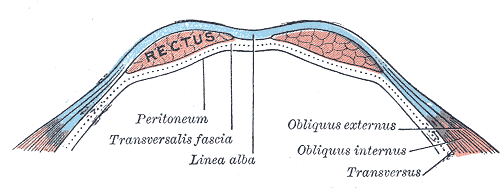 The image to the right is a cross section of the rectus abdominal muscle, commonly referred to as your abs. If they are weak they will probably be small. As they get stronger they grow like most other muscles in the body. However people have a layer of fat over the abs. Depending on how much fat you may or may not be able to see your abdominal muscles. Training your abs will make them stronger (and bigger) losing body fat will help them show up. If you want visible abs you need somewhere between 5-10% fat for men or 12-20% for women. Genetics determines where your body lays down fat and you can't burn fat in only one area. However you can lower your overall fat.
The image to the right is a cross section of the rectus abdominal muscle, commonly referred to as your abs. If they are weak they will probably be small. As they get stronger they grow like most other muscles in the body. However people have a layer of fat over the abs. Depending on how much fat you may or may not be able to see your abdominal muscles. Training your abs will make them stronger (and bigger) losing body fat will help them show up. If you want visible abs you need somewhere between 5-10% fat for men or 12-20% for women. Genetics determines where your body lays down fat and you can't burn fat in only one area. However you can lower your overall fat.
Training as described in step two next, will help with the strengthening and growth of the muscles. It will also contribute to fat loss by boosting the metabolism and burning a few calories.
A good diet as described in step three later will be the best way to loose fat. A good diet is also essential for muscle growth and repair that will be triggered by the training stage (step two).
Step two:
Start training
For quick improvements here is a basic plan, adapt it to fit your needs and ability. A good starting point is to have 4 sessions a week of which 2 are hard abdominal work outs, the other sessions are top ups. The light sessions should cause an ache immediately after the exercise but not the next morning. Hard sessions should keep you feeling the ache the next day. Remember to listen to your body; if it aches too much the next day, rest, you probably worked too hard. If you can't feel the ache at any point after a "hard" work out you probably didn't work hard enough. If a different part of you hurts (back or legs) you're probably doing it wrong. When you find out what makes your Abs and oblique's ache you're probably on the right track so keep it up and do little tweaks as needed.
Example Workout
| Mon | Tue | Wed | Thu | Fri | Sat | Sun |
|---|---|---|---|---|---|---|
| Light session | Hard session | Rest | Rest | Hard session | Rest | Light session |
The standard crunch:
It's all about quality not quantity! 3 sets of 10 good crunches will cause far more abdominal ache and later improvement than 100 bad crunches. It does not matter if you cannot get your hands up to your knees or even your shoulders off the floor to start with so long as you are just engaging your abs.
How To
Lie on your back with your feet on the floor and knees bent and place your hands on the top of your thighs. Look at a point on the ceiling directly above you (or slightly back from where you are lying). Pull your abs in towards the floor as you take a deep breath, then contract your abs and push your hands up your thigh as you lift your shoulders off the floor and breathe out keeping your head looking up at the same point (not forwards). As your hands reach the knee don't go any higher and hold it there while you breathe all the air out and "crunch" the abs. Once all the air is out start to lower your shoulders back down and breathe in as your hands come down. Once your shoulders touch the floor pull the abs down again and repeat. Don't take a break in between crunches. The tempo should be: 2 seconds to get up, 4 second hold at the top, 2 seconds down and 1 second to breathe in before you repeat. Always go until it starts to ache (or until technical failure). If this is above 15 or 20 try some of the below to make it harder, holding it longer is particularly effective. For rugged abs it's recommended to do sets up to about 12, for flat abs go for higher reps.
How to make it harder
- Putting your hands behind your head.
- Holding at the top for longer (up to 10 seconds or so).
- Holding a weight plate on your chest.
- Lowering the bend in your legs until your legs are flat on the floor.
- Punch and Crunch - stop half way up and get someone to hit your abs lightly (with a glove or focus mitt) and then carry on up and chain punch a focus mitt a few times before going back down.
The oblique crunch:
Once again it's about quality not quantity. This is much like the standard crunch except the feet are off the floor.
How To
Bring one leg in with a bent knee towards the body and the other leg should be out parallel to the floor almost completely straight. The leg should be a few inches off the floor. Place the hands behind the ears or head and perform a crunch exactly as described above, remembering to pull the abs in first and breathe all the air out on the way up and keep looking up (and slightly back). Some people like to change the bent leg on each rep like cycling with the feet, others prefer to do 10 reps with one leg bent then change and do 10 with the other leg bent. Remember to train both sides. The same tempo as before is good, this should be: 2 seconds to get up, 4 second hold at the top, 2 seconds down and 1 second to breathe in before you repeat. Keep going with these until tired or until failure (even if this is only 2 each side to start with).
To make it harder you could
- Holding at the top for longer (up to 10 seconds or so)
- Holding a weight plate behind your head
- Touch your opposite elbow to your bent knee
Oblique variation one
Hold a weight in each hand (plate, dumbbell, or wrist weight) in front of your chest (with feet on the floor like a standard crunch or off the floor like in the oblique crunch). Crunch up remembering all the key points, then twist to the left side and punch out with the right hand so the arm is parallel to the floor, bring the arm back. Then turn to the right and punch out with the left hand and bring that back and return from the crunch and repeat. This will hammer the oblique's and help with turning power but make sure you get the weight right and warm up with an easy exercise first.
Oblique variation two
Do a standard crunch but push the right hand to the outside of the left knee and then go back down and crunch again with the left hand going to the outside of the right knee.
The L hang and hanging leg raise
This can be done from a chin up bar or a triceps dip bar, even a bench will work, especially a steep incline bench or if your particularly fit it can be done on the fingers/knuckles on the floor. Sure these are not all L "hangs" but the principle and work they put on the lower part of your rectus abdominal muscle is all the same.
How To
The chin up bar is the easy way, just hang from a chin up bar with your legs outstretched in an L shape. If you can't manage this at first bend your knees and keep your thighs horizontal. On a Tricep dip bar do the same thing with your legs but rest your arms on the bar to support yourself. If doing it on a bench perch yourself as close to the edge of the bench and support yourself with your arms on the bench and raise and lower your legs repeatedly keeping your back straight. If you have an incline bench lie on it with your head at the top holding on with your arms and L hang with your back flat against it. If doing it on the floor push your bum off the floor with your fingers or knuckles and hold the L that way.
Make it harder
By strapping on ankle weights, or of sitting on the edge of a bench you can try resting a weight play on your shins but be careful
The Plank
This exercise makes for a good warm up and can also be very good for training the core of the body.
How to
Lie face down on the floor with your elbows by your body and your hands by your face palm down. Push your body off the floor so your shoulders are above your elbow and your bum and back is horizontally flat in line with your shoulder. Make sure you tense your abs and just hold it. Don't let your trunk sag, it must stay flat. As soon as you can no longer keep your back straight stop.
Make it harder
Put a weight plate on your back (I use one or two 10Kg plates) or / and or lift one arm or on leg, or one arm and one leg off the floor. Ensure your shoulders stay flat when doing this.
Step three
Eat well.
You need to eat well to ensure quick improvement in strength and muscle growth. Protein is very important and if you carry excess weight that needs to be lost then lower your calorie intake (eat less). Protein is pretty good for helping your body feel full so upping the protein intake as specified in the nutrition for martial arts article. Another good tip is eating more often. For example once you have found your right calorie intake spread out what you eat into 5 or 6 meals a day instead of eating fewer big meals. This stops spikes and troughs in your blood sugar which helps regulate insulin production which has been shown to help build lean muscle and lose excess fat. If you read and follow the nutrition for martial arts article you will be on the right track to a good lean fighting weight.

